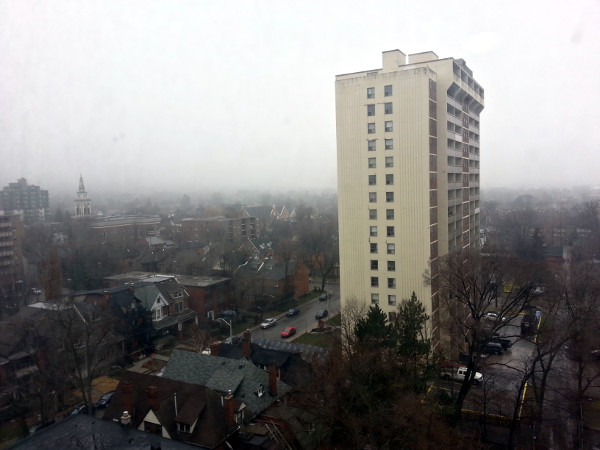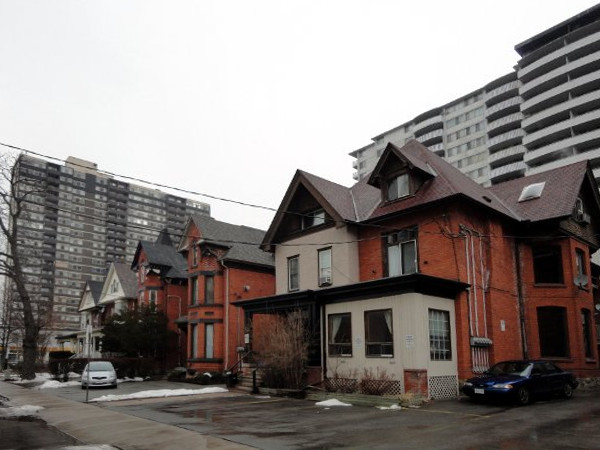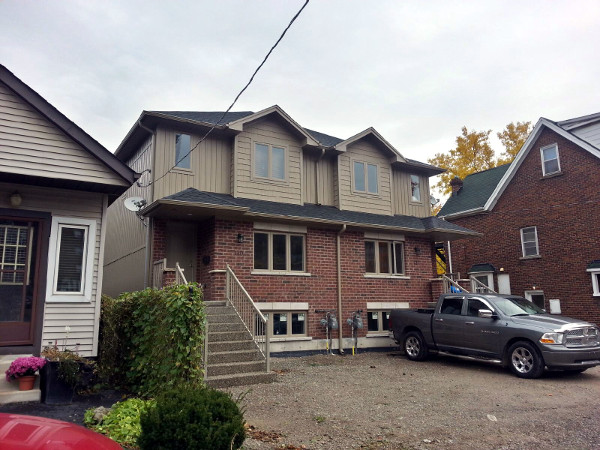Durand residents deserve 21st century zoning that protects the character of their neighbourhood and facilitates good infill development.
By Frances Murray and Yonatan Rozenszajn
Published November 30, 2015
On November 17, 2015, Durand residents who gathered for the annual Durand Neighbourhood Association's Annual General Meeting were treated to the unveiling of the new Durand Neighbourhood Character Project.

Overlooking houses and apartments in Durand (RTH file photo)
Our project consultants, Paul Shaker and Sonja MacDonald of CivicPlan, presented the concept and its possible application to Durand. You can download a copy of their presentation [PDF].
The genesis of this project harkens back to the battles of the early 1970s when low lying historic homes were demolished in favour new high rise buildings. Apart from the collateral loss of heritage, the planning of those high-rises generally failed to pay any attention to the dominant character of Durand, forever altering it to the detriment of all residents.

Houses and apartment buildings in Durand (RTH file photo)
Similar challenges are in place today with the City and developers struggling to make new infill developments comply with antiquated zoning bylaws.
The zoning framework today mimics the set-backs of a suburban subdivision together with overtly generous height allowances. It bears no resemblance to the historic street landscape.
Developers must resort to expensive site specific zoning changes or complex variances to win approval for infill projects that fit well with existing houses.

Deeply set-back infill houses (RTH file photo)
Summertime consultation between city staff, Councillor Jason Farr and board members Janice Brown, Yonatan Rozenszajn, Wes Jamieson and Geoff Roche revealed that character or "form-based" zoning may have application to mature residential neighbourhoods like Durand.
Form-based zoning focuses on the character of a neighbourhood to guide infill development. As Paul Shaker explained at our AGM, Character can be defined as the recurrence or prevalence of patterns of:
The City of Ottawa has recently adopted character based zoning for some of its mature residential neighbourhoods. It uses the approach: "Your street gives you your rules."
Property owners retain complete architectural freedom as long as three key streetscape attributes are retained. These attributes are the dominant character attributes and should be maintained or strengthened.
Unlike heritage conservation laws, which dictate the look of existing structures, character-based zoning may only apply to new infill developments or new and permanent uses of land that may require some development approval from the City's planning staff.
So, what's next for Duranders?
If you are interested in supporting this grassroots project or would like more information, please email us at info@durandna.com.
By fmurray (registered) | Posted December 01, 2015 at 18:37:08
Hi Alberta,
Just to clarify, the proposed Character zoning would only affect low-rise residential, and is for established neighbourhoods like Durand.
Basically, the zoning layer will look at dominant characters of the 21 neighbouring houses in terms of front-facing entrance, parking (in front), etc. It will not have any authority over paint colour, and will have nothing to say about anything done in the backyard such as clothes lines or urban chickens.
We are hoping this new layer will prevent the kind of block-busting by developers that occurred in the 60s and 70s and is starting to creep back (see 1 St. James Place). People find the Durand neighbourhood attractive precisely because of the heritage and history it currently contains. That "development creep" will eventually wipe out the solid housing stock in favour of highrise buildings. This is not NIMBY. The Durand is already the most intensified in the city in terms of people/sq km, and there are plenty of empty lots currently used for parking that can be used for intensification within the urban boundary.
By KevinLove (registered) | Posted December 01, 2015 at 20:52:56 in reply to Comment 115290
I remember in the 1970's when downtown Toronto was blighted with car parking lots. They are all gone, having been replaced with useful things.
They changed. We can too.
You must be logged in to comment.
There are no upcoming events right now.
Why not post one?